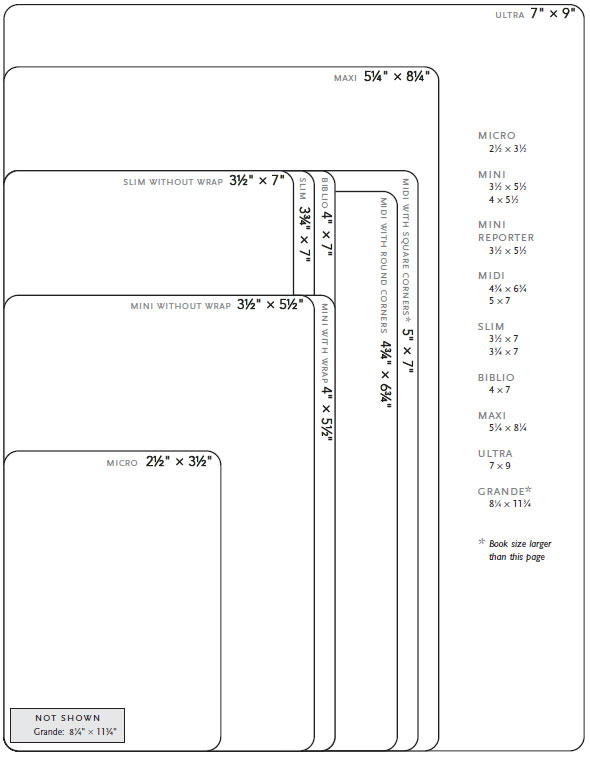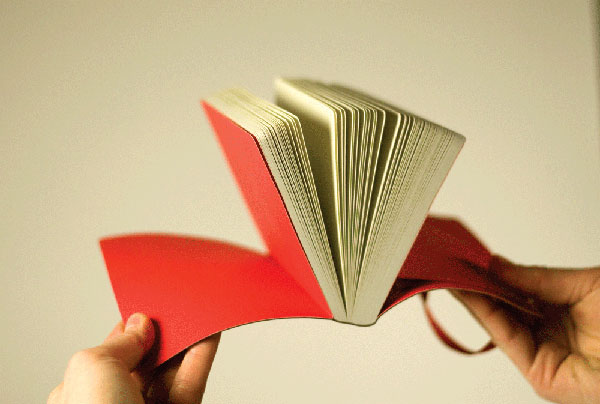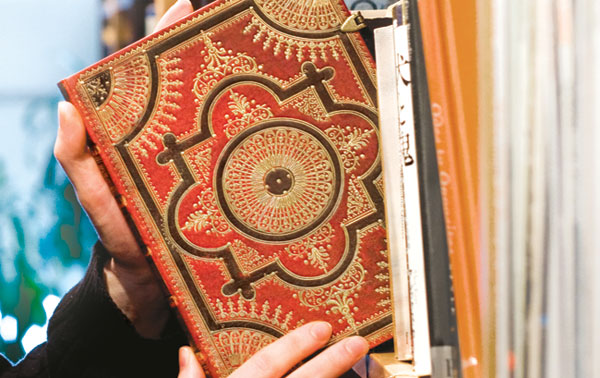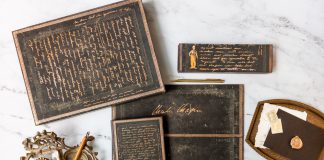Before jumping into the world of journaling and keeping a journal every writer is faced with an important task — choosing the exact right journal/notebook for their needs! This may depend on personal preference or it might depend on what the journal is going to be used for. In either situation, here are 5 factors to consider before making that important purchase:
 1. Size of Journal
1. Size of Journal
The size of the journal you choose depends on your needs. You may want a mini or slim journal because it’s more portable (for carrying around in your back-pocket or purse), or you might want larger Ultra- or Grande-size journals for writing large and long pages of text.
Sizes (and their approximate dimensions) include, from smallest to largest:
- Micro: 70 x 90 mm | 2.75″ x 3.625″
- Mini: 95 x 140 mm | 4″ x 5.5″
- Midi: 120 x 170 mm | 5″ x 7″
- Slim: 90 x 180 mm | 3.75″ x 7″
- Ultra: 180 x 230 mm | 7″ x 9″
- Grande: 210 x 300 mm | 8.25″ x 11.75″
Click on the chart on the right for size comparisons.
You may have to try journaling on a few different size books before you figure out exactly which size is the best fit for you!
2. Binding Quality
Your choice in binding depends on how well-built you want or need the book to be. Do you need a finely-constructed book that can weather any storm or is your book generally always going to be in a safe place (like next to your bed)? If you’re carrying your book everywhere or the thought of pages falling out of your notebook horrifies you, you may want to bypass that cheap generic-brand notebook and spend a little extra on a finely-bound one.
Also important: Do you want the book to lay completely flat when open or are you fine with having to hold it open when you write in it? (See the below picture for an example of a book that doesn’t have lay-flat binding.) Finally, think about what kind of spine you would prefer. A hardcover or stitched/sewn style looks nicer (on the go and in a personal library) than, say, a coil-bound book! (Not to mention that a coil-bound book is not always pleasant to write in if you’re a lefty, with the edge of your hand constantly rubbing up against the rings!)

3. Cover Design
Even the cover design of a book may be important. Some people may want a simple and subtle design (think Paperblanks’ Old Leather or Pocket Companions collections), while others may draw inspiration from something more colorful or lively (ex. Laurel Burch Collections), ornate or elegant (think: Baroque Ventaglio Collection), or personal: We’ve found some people are simply inspired by owning a book from the Embellished Manuscripts Collection because the covers depict the notes and sketches of one of their favourite artists (Think a fan of Edgar Allan Poe drawing inspiration from the famous writer by writing every day in the Poe, Tamerlane journal.)
Which is all to say that – the right cover design can inspire the writer!
4. Paper Quality
You may be fine with any kind of paper or you may specifically like something higher-grade. Higher-grade paper will have a smooth finish, a high opacity (the extent to which printing on one side of the paper will be visible on the reverse side) and minimal to no feathering. Feathering occurs when the ink spreads out on the page (go here for an example.)
Another consideration: your choice of writing instrument should go hand in hand with your choice in paper quality. You don’t, for example, want to use a really nice fountain pen on low-grade paper!
5. Closure

The final factor to consider is what kind of closure you like for your writing journal. There are 3 types of closures you can typically find on a journal:
- Elastic band
- Metal Clasp
- Magnetic Clasp/Wrap/Strap
Obviously some clasps look nicer than others (call us crazy, but we think metal clasps – depicted on the right – look elegant and beautiful on a journal!) but generally all closures will serve the same purpose – keeping your book closed and secure and keeping any extras securely locked away inside the book!

However, if you do typically keep a lot of loose items (photos, loose papers, stickies) in your journal you may want to be careful about your choice of closure. Journals with metal and magnetic clasps and wraps can usually fit some extras, but if too much is added then the magnets may not align as well and the closure will not be as strong. In this case, an elastic band closure may be best. But generally most closures can withstand a book fitting a lot of extras!
Have We Missed Anything?
If we’ve missed anything important feel free to tell us in the comments section below!
About Paperblanks: We have been producing superb writing journals for nearly twenty years. We are book people, and we believe that the written word matters and that our blank books have a critical role to play in the art and continued practice of writing itself. For more about Paperblanks, go to our website at paperblanks.com.







Also, one other thing for me to remember on looking at the size of the book is the fact that (besides writing in it) I like to use a glue-runner and paste things into it. I paste in newspaper articles, concert programs, movie tickets, etc., in order to preserve the memory. Just a thought 🙂
Good point, Katy! You’re obviously not going to be able to fit newspaper articles and concert programs into a micro- or mini-sized journal. 🙂
What i think i need is a book that has lines on one side and plain paper on the other or 1/2 amd 1/2 as i will be doing an educational journal containing research notes but would like to include small sketches/watercolours so would need a high grade paper too. Is there anything like this? 🙂
well explained